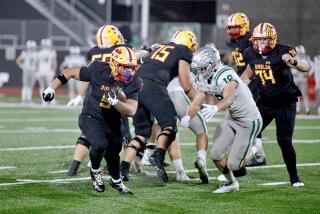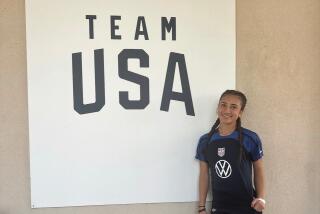CSUN Coaches Need Scholarships to Be Competitive
- Share via
Nary was heard a discouraging word at Thursday’s press conference after Cal State Northridge President James W. Cleary announced that the school has decided to move up to NCAA Division I in all sports but football, probably by the fall of 1990.
The CSUN coaches on hand were all smiles. They liked what they heard.
But most remained cautious while awaiting another sound: that of the other shoe dropping.
They were like children crowding around the tree on Christmas morning. Looks tremendous but which presents are mine? How big a piece of the pie do I get?
“I think the move is very deserving for a community of around one million people and a student body of 30,000,” said Pete Cassidy, the men’s basketball coach. “But how much do we need to be competitive? That depends on who we have to play. If I’m going against an Indiana, a Georgetown or a UNLV, I’m going to need a hell of a lot more. But you don’t have to have an enormous budget. Look at what a Loyola Marymount did this year.”
Division I rules permit 15 full scholarships in basketball. Northridge currently has five.
“You of course have to have a minimum budget and staff,” Cassidy said, “and I don’t claim we’re at that level yet. It’s like climbing a mountain. You have to start with the first step.”
Part of the master plan for this expansion is an 8,000-10,000 seat arena.
“Having the arena,” Cassidy said, “is critical for us. We are going into deep water and we’re going to have to learn to swim better.”
Speaking of swimming, which Pete Accardy usually does, what does the move mean for a swim program that has produced Division II national championships for both the men and women, including nine in a row for the men from 1975 to 1984 and women’s titles the past two years?
“I think it’s a greater challenge developing kids capable of winning in Division I,” said Accardy, coach for both men’s and women’s teams. “Some sports are going to have greater priority under this new setup. I don’t know yet where swimming will be and that is the obvious key.
“We have had very little to work with--one and a half scholarships for men and one and a quarter for women--so anything would be an improvement. The NCAA maximum is nine. We will need at least five. Hopefully we can get that within five years.”
Another big gain, Accardy said, is that he can now sit down with a recruit and offer a Division I program.
“Despite all that we have produced,” he said, “we have lost many kids along the way simply because we are not a Division I school. Even though we did all we could, it wasn’t enough.”
Marwan Ass’ad, the soccer coach, concludes the rest of the school has finally caught up with him.
“As far as I’m concerned,” Ass’ad said, “we’ve been Division I for four years. To us, this is just a technicality. We’ve been a Division I team that has been competing in Division II. When we beat Fresno State two years ago, it would be like our basketball team beating Indiana.
“Our fans are going to love it. They don’t have to wait for the playoffs now to see great games. We don’t have to wait for the mercy of Division I teams to come play us at home. Now, they have to play us.”
For one coach, the switch in direction still leaves two roads from which to choose.
“We have to see which way the athletic department wants to go,” said Don Strametz, men’s and women’s track and field coach. “We could choose to go the dual-meet route and try to get ourselves ranked high nationally by Track and Field News or we could take three, four or five exceptional athletes, give them full scholarships and try to score well at the national championships. My choice would be the first one, but we have to see which is more feasible.”
Either way, Strametz approves of the university’s new status.
“Academics have always been a strong selling point for this school,” he said. “We haven’t lost kids because of that, but we have lost some because we’re Division II. This should open up a lot of avenues.”
Walt Ker, the women’s volleyball coach whose teams have won two Division II championships in the past five years and earned eight consecutive trips to the Final Four, was happy Thursday simply because he won’t have to answer the same old question anymore.
“People are always asking me when I’m going to move to a Division I school,” he said. “I like where I live and now I can have the best of both worlds.
“One of the biggest things may be my release time. Seventy-five percent of my work load is spent teaching classes and only 25 percent coaching volleyball. Hopefully there will now be a reversal of roles to give me adequate time to go out and do the job of recruiting and fund-raising. This should give me the time to do a much better job. I hope I’ll be changing hats.”
In Division I, the maximum for women’s volleyball is a dozen full scholarships. And that’s the number Ker is circling as a realistic goal.
“We have two and a quarter now,” he said. “If we can pick up a couple a year, we could have the 12 in five years.”
The only coach at Thursday’s press conference who wasn’t directly affected was football Coach Bob Burt. Ascending to Division I in his sport is a step his school will not take at least until the new 20,000-seat football stadium is completed sometime in the next five years.
But Burt was just as happy as his colleagues Thursday.
“I don’t see how it can do anything but help our credibility,” he said of the division switch. “If all the other houses on your block are suddenly worth $1 million and yours is worth $100,000, obviously your property value will go up.”
More to Read
Get our high school sports newsletter
Prep Rally is devoted to the SoCal high school sports experience, bringing you scores, stories and a behind-the-scenes look at what makes prep sports so popular.
You may occasionally receive promotional content from the Los Angeles Times.






